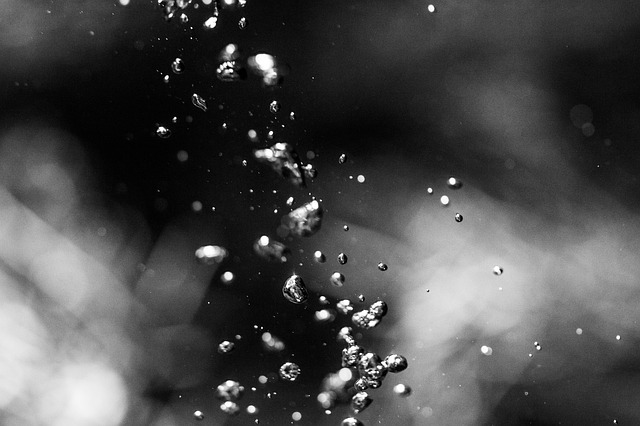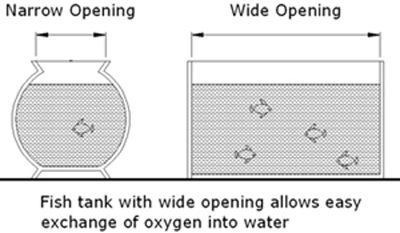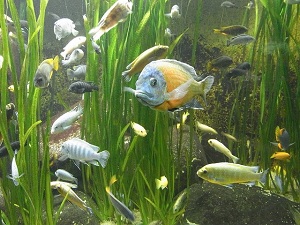Many tank owners are looking for answer to this vital question, how to get more oxygen in your fish tank? The reason behind this is simple, fish survive on dissolved oxygen and if the oxygen levels are decreased then fish gasp at the surface of the fish tank.
There are many reasons that affect oxygen quantity in a fish tank and to avoid this you must observe the tank and fish behavior carefully. The surest way to know if a tank has less amount of oxygen is by observing fish behavior.
Table of Contents
Symptoms of low oxygen levels in a fish tank
There are some symptoms by which you can tell that a tank has less amount of oxygen dissolved in it’s water.
1) If fish are gasping for air at the surface of the water then this could be a sign that water has less amount of dissolved oxygen. However some fish species such as Betta, occasionally travel to the top surface and consume some oxygen from air, so do not get confused about this. If just one fish is gasping for air then this could be due to some kind of illness.
2) If oxygen levels are decreased then fish movement becomes slow and they become sluggish. Only a careful and observant fish tank owner can tell the difference between normal fish movements and slow movements. That is why always keep an eye on your fish behavior.
3) When oxygen levels are decreased, fish breath heavily. Because of low levels of oxygen fish try hard to breath in the available oxygen in the water resulting in extra efforts of heavy breathing. If not cured immediately, this can lead to death as well because of suffocating.
4) When oxygen levels are decreased fish eat less food than normal. This lead to lots of uneaten food settled at the bottom of the tank that gets decayed. If not taken care of uneaten food gets converted into toxic gases further making the conditions worst.
How Oxygen Gets Mixed in Fish Tank Water?

Before we discuss ways to increase oxygen in fish tank water, it is necessary to understand how it gets mixed in water.
If you have observed in fish tank, air bubbles are coming out from a tube. These bubbles rise to the top of water surface and get released in the surrounding air. Many people have a belief that these bubbles release oxygen in the water but that is not true.
When bubbles are rising, a small portion of air inside the bubbles get mixed in the fish tank water but the real gas exchange takes place at the surface of the water. The primary purpose of the bubbles is to agitate the water surface so that gas exchange becomes easier.
The surface area of the water on top gets disturbed and thus increases it’s surface area making it easier to exchange gases between water and surrounding air. Excess carbon Dioxide (CO2) from the water gets out and surrounding Oxygen (O2) gets in the water which is needed for fish to survive. In natural world this process is happening continuously.
Since water in fish tank is stationary and static it is necessary to create artificial currents at the surface so that exchange of carbon dioxide and oxygen is happening continuously. All fish tank accessories in a fish tank such as bubblers, filters, powerheds are designed to achieve this main purpose in mind.
Never keep fish in a fish bowl
The reason why a bowl is not recommended for keeping fish is that the top opening of the bowl is always narrower than a fish tank. Most bowls are round in shape with a narrow opening. This restricts easy exchange if air between water and surroundings. But in a fish tank since the top area is wider, it is comparatively easier to transfer oxygen and carbon dioxide between the water and surroundings.

Some Ways to Increase Oxygen In Your Fish Tank
Here are 4 easy ways to increase oxygen in your fish tank.
1) Bubbler with air pump
A bubbler equipment is a simple air tube that is inserted into the fish tank. One end of the tube is in the water and is normally hidden behind trees or under decorating items. The other end is connected to an air pump that forces air into the tube. The forced air then escapes into the water in the form of bubbles and rises to the top surface. These bubbles agitate the water surface increasing it’s surface area. This is where exchange of gases takes place between water and surrounding air.
Many people complain that the air pump makes a hissing noise and is sometimes irritating. To cater this problem you can keep the pump on a thick and soft surface such as a sponge, towel or a rubber pad. The air pump has moving parts in it and they are likely to vibrate creating a hissing noise.
Many people prefer fixing an air stone at the other end of the tube which is dispersed in the fish tank. The air stone breaks the air into multiple bubbles creating an amazing look. If you don’t want to use an air stone you can even hide the open end under the substrate, decorating items or stone formations.
2) Powerhead
A powerhead is way to forcefully circulate water within the fish tank itself so that the surface of the water gets agitated encouraging gas exchange easily. The power of a powerhead is measured in Gallons/hour. This means how many gallons of water is circulated in an hour of running.
Normally powerheads are fixed just below the water level slightly facing upwards to create a constant current of water by circulating it within the tank. Due it efficiency in circulating the entire water surface, it is considered a better option than the bubbler system.
Sometimes a powerhead is used at the bottom of the tank as well. It is located just above the substrate level to blow off any solid particles that are likely to rest on the surface and decay later. This action also helps in circulating the water thoroughly making it easier for gas exchange.
3) Aquarium wave maker
Aquarium wave maker is similar to a powerhead but the only difference is it’s location in the fish tank. A wave maker is installed at the upper half of the tank in it’s height submerged in water pointing upwards. When turned on this creates a circular movement in the water in wave forms.
Normally you can install it on the same end of the filter intake because when water gets circulated it also carries with it solid particles such as solid waste, uneaten food particles, fallen leaves, dirt on the substrate with it forces towards the filter intake tube. The filter tubes at the bottom of the tank then sucks in these things easily and the tank remains substantially cleaner than before.
To help the water current developed by the wave maker it is always better to point the direction of the filter outlets away from the wave maker. This will ensure that the water coming out of filter is carried away with the wave generated by the wave maker towards bottom of the tank.
If your tank is big enough then it requires two wave makers to completely circulate the water evenly through out the tank. In that case the second wave maker must be installed on the opposite end of the tank but at the bottom so that the water pushed by the first wave maker reaches the bottom where it meets the force of the second wave maker and is carried further back towards the first one in a circular motion. If you plan to use a second wave maker then it is always better to point it towards the filer tube of the opposite side of the tank and place it just above the substrate levels. Alternatively you can also use two wave makers with different power outputs.
The power of a wave maker is measured in gallons/hour. Normally for a 75 gallons (48 inches x 18 inches x 20 inches) tank you can use two wave makers on opposite ends. The main one can be a combination of two with 1200-1500 gallons/hour power located at the upper half of the tank pointing upwards and the opposite one can be a smaller one with around 600-800 Gallons/hour power located just above the substrate level.
The circular waves also helps in agitating the surface water encouraging gas exchange at the top levels. Since Oxygen and carbon dioxide get exchange at the top levels, by circulating the water, the distribution of oxygen becomes even in the entire tank and fish get a fresh dose of oxygen everyday. For best results and continuous oxygen supply in your tank, you can run the powerheads all the time without interruption.
3) Live plants
Live plants in an aquarium not only provide an amazing display of natural beauty but at the same time provide an important purpose of releasing oxygen in water. Plants consume carbon dioxide and ammonia formed by solid waste and release oxygen which is consumed by fish for energy and living.

If you have all the other equipment installed in your tank such as bubbler, wave makers or powerheads then you can first measure how much are the present oxygen levels in the tank using a water testing kit. The ideal levels of oxygen would be 4-10 PPM (Parts Per Million). By adding plants you would be adding a little bit more to these levels.
Though release of oxygen by plants won’t be as high as the amount of exchange taking place at the surface level it is necessary to keep testing water for excess of oxygen as well. Too much oxygen in water is not recommended because it leads to an illness in fish.
4) Spray bars
A spray bar is an ingenuous way to agitate the water surface for easy exchange of gases at the surface levels. If you have a canister filter attached to the fish tank then instead of throwing the purified water into the fish tank directly, it can be released in the water trough spray bar. A construction of a spray bar is like a flute (the musical instruments) with holes at regular intervals along it’s length. The water gets sprayed through the holes along the length and this agitates the water surface evenly encouraging gas exchange. Spray bars are easy to setup and even easy to make at home if you are really want to save money.
With these methods that encourage mixing of more oxygen in your fish tank it is necessary to also look at reasons why oxygen levels your fish tank are falling down. If not treated this can lead to fish deaths.
1) Overstocking you fish tank with too many fish is a common reason for lowering oxygen levels. With more fish struggling or competing for the same amount of oxygen it is bound to get lower and fish suffering by gasping for air at the surface.
2) Lack of equipment that encourages easy mixing of oxygen in fish is another very important reason for lowering levels of oxygen. Even if you have all the equipment installed in the tank it is necessary to have look at their capacities to handle the volume of your fish tank.
3) In a tropical tank, water being slightly warmer, the capacity of water holding oxygen is slightly less as compared to cold water tanks. That is why in tropical tanks all the necessary arrangements for easy oxygen exchange must be provided with proper capacities.
4) Do not feed your fish too much food as fish don’t eat all of it and uneaten food gets settled down at the substrate level encouraging decay and formation of excess ammonia gas.
5) If you have a sick fish in your tank then it is important to transfer him to a quarantine tank for treatment. Any kind of medication added to treat him in the main tank can lower oxygen level drastically. Always have a quarantine tank for treating sock fish.